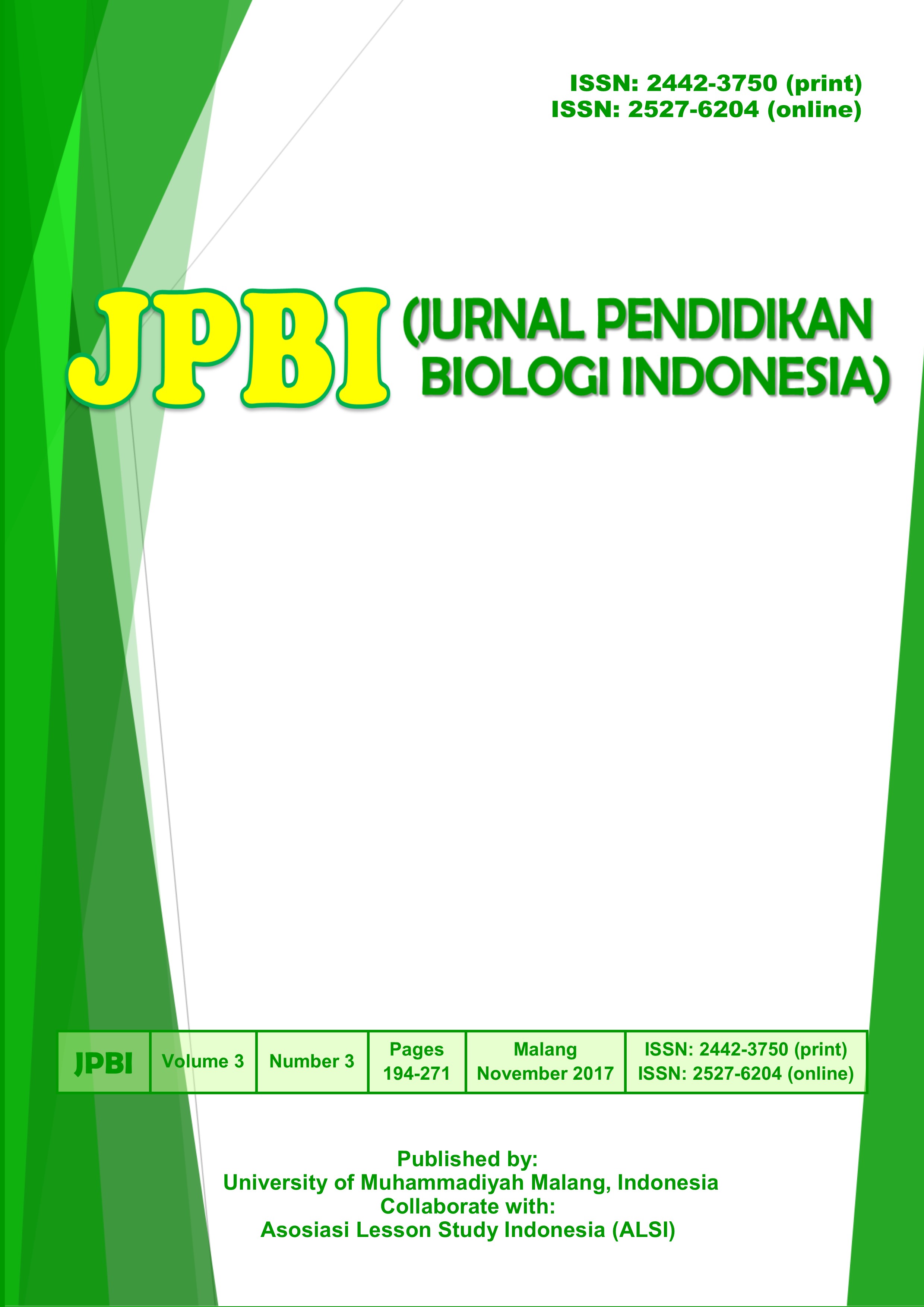Comparison the number of bacteria between washing hands using soap and hand sanitizer as a bacteriology learning resource for students
DOI:
https://doi.org/10.22219/jpbi.v3i3.4862Keywords:
Hand sanitizer, liquid soap, total number of bacteriaAbstract
Hands are the principal carriers of bacterial diseases, therefore very important to know that washing hands with soap or hand sanitizer is highly effective healthy behaviors to reduce bacteria in the palm. This study aimed to determine the total number of bacteria between washing hands with soap and hand sanitizer, also applying the results of these studies as a learning resource in bacteriology. The research design was the true experiment with pretest-posttest control group research design and laboratory examination. Analysis of data using paired t-test and independent sample t-test with α = 0.05. The result using paired t-test obtained t count= 2.48921> t 0.05 (14) = 2.14479 (with liquid soap), obtained t count= 2.32937> t 0.05 (14) = 2.14479 (with hand sanitizer). As for the comparison of the total number of bacteria include washing hands with soap and hand sanitizer using independent samples t-test obtained results there were differences in the total number of bacteria include washing hands with liquid soap and hand sanitizer with t count= 2.23755> t 0.05 ( 13) = 2.16037. That results showed hand sanitizer more effective to reduce the number of bacteria than the liquid soap, that was hand sanitizer 96% and liquid soap by 95%.
Downloads
References
Cordita, R. N. (2017) .Perbandungan efektivitas mencuci tangan menggunakan hand sanitizer dengan sabun antiseptik pada tenaga kesehatan di ICU Dr.HABDUL MOELOEK. Bandarlampung: Fakultas Kedokteran Universitas Lampung.
Ministry of Health Republic of Indonesia (2008). Pusat promosi kesehatan dalam pencapaian PHBS. Jakarta: Ministry of Health Republic of Indonesia.
Desiyanto, F. A., & Djanah, S. N. (2013). Efektifitas mencuci tangan menggunakan cairan pembersih tangan antiseptik (Hand sanitizer) terhadap jumlah angka kuman. Jurnal Kesmas, 2, 55-122. DOI: http://dx.doi.org/10.12928/kesmas.v7i2.1041
Levinson, W. (2008). Review of medical microbiology & immunology. Tenth Edition. New York: The McGraw-Hill Companies, Inc.
Murray. (2005). Medical microbiology. 6th ed. Canada: Mosby.
Retno, R. S., & Yuhanna, W. L. (2016). The learning of science basic concept by using scientifiq inquiry to improve student’s thinking, working, and scientific attitude abilities. Jurnal Pendidikan Biologi Indonesia, 2(1), 1-9. Retrieved from http://ejournal.umm.ac.id/index.php/jpbi/.
Rosita, D., Zaenab, S., & Budiyanto, M. A. K. (2016). The analysis on the chlorine contents in rice circulation in pasar besar of Malang as the biological learning resource. Jurnal Pendidikan Biologi Indonesia, 2(1), 88-93. Retrieved from ejournal.umm.ac.id/index. php/jpbi/article/view/3386.
Shu, M. (2013). Formulasi sediaan gel hand sanitizer dengan bahan aktif triklosan 0,5% dan 1%. Calyptra: Jurnal Ilmiah Mahasiswa Universitas Surabaya, 2(1), 1-14. Retrieved from https://journal.ubaya.ac.id/index.php/ jimus/article/download/173/150.
Sibuea, W. H., Panggabean, M. M., & Gultom, S. P. (2007). Ilmu penyakit dalam. Jakarta: Rineka Cipta
Sunarti, S. (2015). Effectiveness of hand wash to the decrese in number of germs on the visitor of badan perpustakaan daerah provinsi kalimantan timur. Jurnal Ilmu Kesehatan. Retrieved from ojs.stikesmuda.ac.id/index. php/ilmu-kesehatan/article/view/.
USAID Indonesia. (2009). Enviromental services project. Retrieved from http://indonesia.usaid.gov/en/Activity.160.aspx.htm.
Wahdiniati, L. (2016). The examinaton of Salmonella sp. and Escherichia coli content on fish-paste in Klampis market of Bangkalan Madura as biology learning resource. Jurnal Pendidikan Biologi Indonesia. 2(2), 198-205. Retrieved from http://ejournal.umm.ac.id/index.php/jpbi/.
Purwatiningsih, S. (2015). Pengaruh penggunaan hand sanitizer terhadap kepatuhan cuci tangan perawat pelaksana di ruang rawat inap RSU Assalam Gemolong, (Unpublished thesis). Surakarta: Stikes Kusuma Husada. Retrieved from http://digilib.stikeskusumahusada.ac.id/files/disk1/23/01-gdl-sripurwant-1145-1-skripsi-h.pdf.
Qisti & Rachmiati. (2009). Sifat kimia sabun transparan dengan penambahan madu pada kosentrasi yang berbeda. (Unpublished thesis). Bogor: Institut Pertanian Bogor.
Rachmawati, F. J., & Triyana, S. Y. (2008). Perbandingan angka kuman pada cuci tangan dengan beberapa bahan sebagai standarisasi kerja di laboratorium Mikrobiologi Fakultas Kedokteran Universitas Islam Indonesia. Jurnal Logika, 5(1), 1410-2315. Retrieved from http://journal.uii.ac.id/index.php/ Logika /article/view/179/167
Radji, M., Suryadi, H., & Ariyanti, D. (2007) Uji efektivitas antimikroba beberapa merek dagang pembersih tangan antiseptic. Majalah Ilmu Kefarmasian, 4(1), 1-6.
Ramadhan, I. (2013). Efek antiseptik merk hend sanitizer terhadap bakteri Staphylococcus Aureus. Jakarta: Universitas Islam Negeri Syarif Hidayatullah. Retrieved from http:// repository.uinjkt.ac.id/dspace/bitstream/123456789/26361/1/IZKAR%20RAMADHAN-FKIK.pdf.
Sarimusrifah, I. M. (2016). Buku penuntun praktikum bakteriologi. Kendari: Poltekkes Kemenkes Kendari Jurusan Analis Kesehatan.
Yuniarti, T. (2007). Penuntun praktikum bakteriologi. Kendari: Poltekkes Kemenkes Kendari
WHO. (2009). WHO guidlines on hand hygiene in health care: A summary. Geneva: World Health Organisation. Retrieved from http://apps.who.int/iris/bitstream/10665/70126/1/WHO_IER_PSP_2009.07_eng.pdf.
Wati, R. (2011). Pengaruh pemberian penyuluhan PHBS tentang cuci tangan terhadap pengetahuan dan sikap mencuci tangan pada siswa kelas V di SDN Bulukantil Surakarta (Unpublished thesis). Surakarta: Fakultas Kedokteran Universitas Sebelas Maret. Retrieved from https://eprints.uns.ac. id/6069/1/197231711201109051.pdf.
Downloads
Published
Issue
Section
License
Authors who publish with JPBI (Jurnal Pendidikan Biologi Indonesia) agree to the following terms:
- For all articles published in JPBI, copyright is retained by the authors. Authors give permission to the publisher to announce the work with conditions. When the manuscript is accepted for publication, the authors agree to automatic transfer of the publishing right to the publisher.
- Authors retain copyright and grant the journal right of first publication with the work simultaneously licensed under a Creative Commons Attribution-ShareAlike 4.0 International License that allows others to share the work with an acknowledgment of the work's authorship and initial publication in this journal.
- Authors are able to enter into separate, additional contractual arrangements for the non-exclusive distribution of the journal's published version of the work (e.g., post it to an institutional repository or publish it in a book), with an acknowledgment of its initial publication in this journal.
- Authors are permitted and encouraged to post their work online (e.g., in institutional repositories or on their website) prior to and during the submission process, as it can lead to productive exchanges, as well as earlier and greater citation of published work (See The Effect of Open Access).

This work is licensed under a Creative Commons Attribution-ShareAlike 4.0 International License.


















